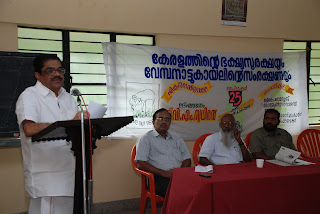Kerala has a continuous chain of lagoons or backwaters along its coastal region. These water bodies are fed by rivers and drain into Arabian sea. The Vembanad wetland system and its associated drainage basins lie in the humid tropical region between 09 00’ – 10 40’N and 76 00’ -77 30’E. It is unique in terms of physiographic, geology, climate, hydrology, land use and flora and fauna. The Vembanad lake is bordered by Alapuzha, Kottayam and Ernakulam districts of Kerala covering an area of about 200Sq. km and extending 80 km NW-SE direction from Munambam in north to Alapuzha in south. The width of the Lake varies from 500m to 7 km and depth from <1m to 12m. The lake has got a freshwater dominant southern zone and salt water dominant northern zone, both separated by a barrage/regulator called Thanneermukkom barrage. The freshwater dominant southern zone is basically known as Kuttanad. This area is part of a fragile but beautiful wetland system, which is declared as Ramsar Site in 2002.
Change in land use pattern and modification of lake water by low mixing, increased pollution, aggressive growth of water weeds, continuous dredging operations and other developmental interventions have led to substantial decline in species diversity and population diversity of flora and fauna in Vembanad. The reclamation has almost decimated the mangrove and associated species diversity, which was once very diverse and luxurious. It also has diverse effect on fish particularly prawn population and bird diversity. The changed ecology is believed to have lost about 23 species of fishes, preventing migration of about 13 other species, led to the decline of 33% of bird population. More than 80% of people in Kuttanad are reported to be relying on the contaminated canal water for their daily needs.
The Vembanad lake is the back bone of Kuttanad economy and in that agriculture is the major economic activity in Kuttanad. Rice and coconut are major crops contributing to about 80% of agricultural income. Kuttanad is one of the ‘rice bowl’ or ‘granary’ of Kerala. In 1967 about 60,921 ha was under paddy in Kuttanad, which in 2003 declined to 37,624 ha. The share of Kuttanad to the state’s total paddy production shrunk from 37% in 1967 to 18% in 2003. It is the livelihood for thousands of people as farmers and agricultural labors and allied sectors. A big majority of the agricultural labors are women
An estimated 12,541 inland fishermen family in Alapuzha and Kottayam are depending on the capture fishery. A community with hardly any assets, they constitute a poorest section in this area, with more than 70% of them below poverty line. Women make up 47.1% of the total fisher work force. It has been estimated that over the last thirty years fish diversity has come down from 150 to 30 species and the fish catch had declined from 1,60,000 ton to 7,200 ton in 1998 and to as low as 687 ton in 2000-2001.
Annual landing of black calm is reported to have plummeted from 27,000 ton in 1968 to 11,652 ton during the mid 80s.
The water spread area of Vembanad both in terms of square area and cubic area has substantially decreased over the last century. It is now 1/3rd of its original size. In 1834, it was 36,329 ha; this reduced to about 23,750 in 1983. Again in 1992 it was 13,224 ha which then reduced to 12,504 ha in 2000.
Backwater tourism, tourist resorts and houseboat cruise is an economic evolution emerged recently by marketing the scenic and natural charm of Kuttanad. Tourism has created a wonderland and invades into Kuttanad without the permission of local people. Unfortunately government is considering only the economic aspects of tourism. Sustainable tourism also has to be sensitive to the use of resources.
In the history of independent Kerala rice cultivation has got the maximum promotion. Government introduced Paddy land Act, giving maximum financial support, in fact the policy of the government itself is barren less paddy land. Even then in the name of development people has approaching government to convert paddy land for developmental purpose. Methren Kayal and Golf based tourism village is a classical example for this. This is not the only case. Each and every day land mafia is accruing ha of paddy fields in different padasekharam. After accruing this they are not cultivating paddy and some of them already converted paddy fields by reclaiming it. This land mafia offer exorbitant prices for paddy fields to get it from the hands of poor farmers.
It is recognized that the current trend of development will negatively impact on the ecology of Kuttanad and thus intern will affect livelihood of the most vulnerable groups as it will reduce access to resources.
Both government has done the initial steps and need further fine turning and assistance from local community and scientific community people concerned in conserving this wet land. There has to be better pressure on government by lay men and vulnerable groups to address the issue and for that the issue has to be discussed in detail.
To assist in framing sustainable and scientific approaches in dealing with wetland, which is again a tourism hub. The productive sector which is the back bone of Kuttanad has to conserve scientifically. There should be meaning for declaring this area as a Ramsar site and the purpose of Dr. M.S. Swaminathan Commission visit and report. The acts and rules framed for the conservation of nature should attain better public audit.


